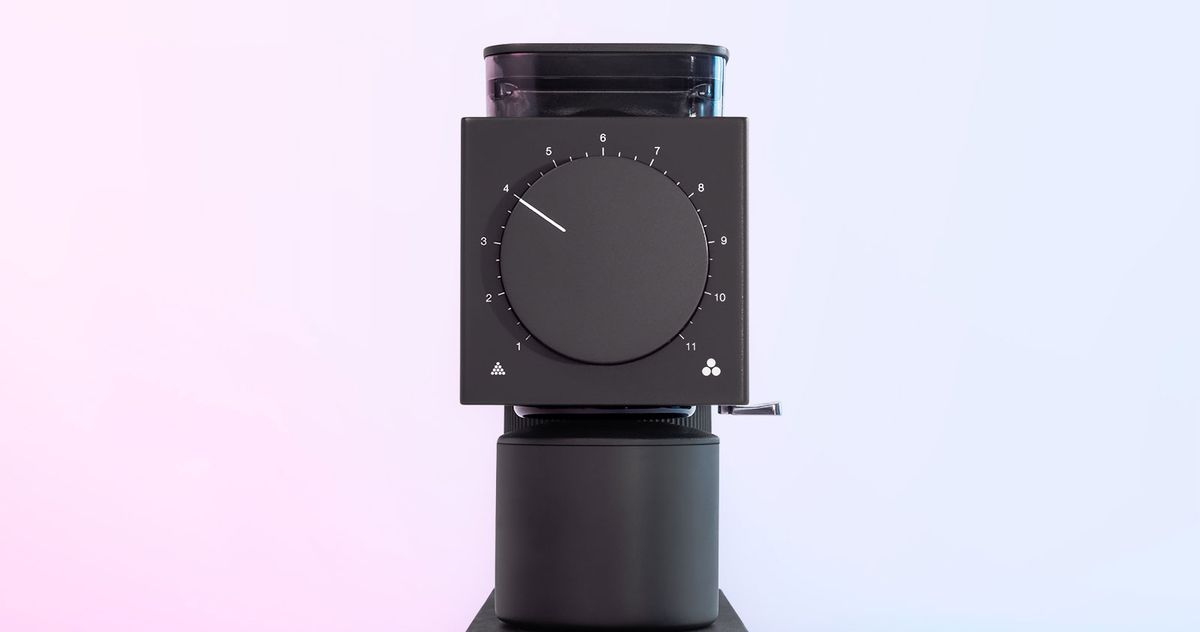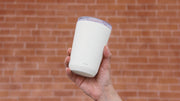The all new Fellow ODE grinder ― A study in design

“Less, but better.”
― Dieter Rams
It’s no secret that Apple products borrowed heavily from Braun designs of yesteryear. If Braun isn’t ringing any bells, go dig around for your mother’s old food processor in the back of the cupboard. Or, see what electric razor is in your grandfather’s bathroom. They could be Braun and might be 30+ years old, but likely still work. In the time before disposable consumer goods and big box store domination, Braun was an esteemed brand known for clean, minimalist design and reliability. The Frankfurt-based company gained widespread recognition in the mid-1960s when head designer Dieter Rams started his run of inspired consumer product designs. I could go on and on about his influence on modern design, in general, and the impact he and his team have had over the years, but I’ll save you. You’re reading this because you’re curious about the Fellow ODE. And you’re asking me what Apple and this German company you vaguely recall have to do with this remarkable coffee grinder. Well, quite a bit, actually.


You see, Fellow’s design team is drawing on a lineage of Rams’ designs, which Apple designers drew from about 20 years ago. This is a deep and rich well, and it’s part of the reason why many of your Apple products look so cool. All Apple products say, “Designed in California.” But they should say, “partially inspired by a cool old German guy named Dieter Rams.” Most people don’t care about appliance aesthetics, and many non-Apple people balk at the premium prices they command. My thinking is, Apple products, much like Fellow products, are tools to be used daily. You will spend a lot of time looking at them, but they should seamlessly integrate into your environment. And if you’re lucky, they should be nice to look at! If you look at many coffee gadgets, they sometimes lack the elegance and minimalism that Braun and Apple espouse. Enter Fellow: since 2014, they’ve been trying to address uninspired design in the coffee world with a specific focus on home pour-over brewing.

Dieter Rams at Braun Headquarters, Frankfurt, 1967
Over the last 6 years, Fellow saw a hole in the home grinder market. Where was the electric filter grinder that not only excelled at grind quality but looked cool sitting on your counter? Taste is subjective, yes, but this grinder didn’t really exist until the ODE came along. When I spoke to Fellow’s founder and CEO Jake Miller in San Francisco back in May, he talked about how Fellow focuses on the intersection of aesthetics and function. I had a hunch that Fellow’s design team took a page out of the Rams playbook, but I had to ask him for confirmation, and he unequivocally said, “yes.” Miller told me that he personally abides by Rams’ “10 Principles for Good Design,” which are:
- Good design is innovative.
- Good design makes a product useful.
- Good design is aesthetic.
- Good design makes a product understandable.
- Good design is unobtrusive.
- Good design is honest.
- Good design is long-lasting.
- Good design is thorough down to the last detail.
- Good design is environmentally friendly.
- Good design is as little design as possible.


Industrial design meets modern chic, for a timeless look
The ODE, and the Fellow suite of coffee brewing products, hit on some of these points for sure. I think this is part of why the company has fast-tracked itself to a respectable place in the industry. The Stagg Kettle was a watershed moment (no pun!) where their clever design was transformative. It was a desperately needed facelift to the variable temperature gooseneck kettles of the world. For many people, much like the iPod for Apple, it put Fellow on the map. The ODE, then, would be Fellow’s iPhone. They saw a hole in the market and knew they had the power to change things.

Fellow's design team working on early Stagg EKG designs, San Francisco
A clean, minimalist, unobtrusive design might seem underwhelming at first. But the simplicity, the smooth, clean lines, the chic all-black industrial steel cloaking a short but well-positioned assemblage of cylinders and rectangles almost seem to be missing something. But that's not the case—it's "less, but better," as Rams famously said. There are no bells and whistles here; it’s everything you need and nothing more. The ODE will sit on your countertop nicely, with its low profile allowing it to hide away unobtrusively.


The Braun ABW-41 clock from 1981 reminds us of something…. Hmm…?
This grinder is meant to do one thing and one thing only: grind coffee really well. The front dial, like the tachometer on a sports car, is front and centre. It goes to 11, so you know they mean business (and have a sense of humour). But what’s under the hood? What are the notable features? The grinder has a powerful, PID-controlled motor that drives 64mm flat steel burrs. Unheard of for a home grinder, Fellow has now raised the bar for what kind of hardware coffee fans can tuck away on their counter. I’ve actually run coffee programs and have done quality control for cafes in the past, so I’ve spent a lot of time with the famed Mahlkonig EK-43 grinder (or “EK,” as the baristas say). And this 40-pound industrial hulk eats through beans at a staggering rate—it's famous for this. I’d almost liken the ODE to a scaled-down version of the EK, with a nearly equal appetite for beans. The ODE, however, doesn’t offer the same stepless grind size range as the EK. If you’re wondering what stepped vs. stepless means, the ODE is a stepped grinder, meaning there are preset notches for each grind setting, for a total of 30. Stepless means that the dial has no notches and moves freely. Unlike the EK and many other grinders, the ODE does not sport a tall, plastic hopper for feeding the beans. The shrunk-down hopper is meant for single-dose, brewing-on-demand, with an 80-gram maximum capacity. This is to discourage people from leaving their beans in the hopper, which accelerates ageing, as it’s not airtight. (If you need an airtight storage solution, Fellow has your back.) The ODE can turn coffee beans into a tight, uniform grind size in record time—much faster (and quieter) than most popular home grinders on the market. This means a more uniform extraction, or, the coffee equivalent to wiping off dirty glasses: a better and cleaner view into the character of the coffee you’re brewing.

Fellow was kind enough to give us an early prototype back in March, and our team in the Calgary office put this grinder through the paces with thousands of grind cycles since then! We’ve had no issues whatsoever, and the grinder has become a permanent fixture of our daily filter brewing. Now you may have heard some ODE criticisms from a certain, highly respected coffee professional across the pond (*cough, James Hoffman, cough*). In a recent review video Hoffman posted, he gave his initial impressions of the machine, and I’d like to address them. Firstly, the issue of this grinder being messy, as it were, is perhaps valid, but I’d invite you to find me an electric grinder that isn’t!? The simple fact of the matter is that any good cafe, or any keen home coffee enthusiast, will always include tidying up in their routine. I keep a small brush on my bar and sweep up the chaff (those papery, light brown coloured flakes inside the bean that love static) and coffee grounds daily. I do this whether using my Baratza Encore, ODE, or even a hand grinder. Secondly, we noticed that Hoffman’s range of grind size was way off from ours. The grinder provides an acceptable range for the majority of our filter brewing needs. For example, personally, I grind at 7.0 on the ODE dial for a 22g pour over, giving me a 2:45-3:00 brew time, which is perfect for my tastes. But if I owned an automatic home brewer, like say the Ratio 6, I’d still have lots of wiggle room on the dial to grind for batch brew. And I’ve been grinding at around 5.0 for my AeroPress brews and 3.5-4.0 for my cloth filter brews; both have resulted in delicious cups. The upper limits—the range of 8.0-11 that I currently don’t use thanks to Covid restrictions—would be perfect for making large Chemex brews for friends. Obviously, you need to spend some time with the grinder to find the right grind setting(s) for you (your next lazy Sunday project!). Still, we guarantee you’ll be able to get precisely the grinds you need to brew delicious filter coffee at home. And to reiterate, the ODE is not intended for super fine grinds or espresso.
I could go on and on about why I love this grinder and why you—or the loved one to whom you might gift it—will, but I won’t! Now is the perfect time to upgrade your coffee game or to set a high bar for gift-giving this season! 2020 has been a very, very tough year for everyone. With the holidays coming, it’s the perfect time to slow down and enjoy a nice cup of coffee, and be thankful for friends, family, and great coffee gadgets!
We may never be as cool as Dieter Rams. But at least we can all tap into a chic lineage of design heritage by buying an ODE. It’s a grinder to marvel at on your counter while achieving incredible, effortless coffee grinding to boot! And while there’s much more to the story of Apple, Braun, Fellow and their design influence, now you may never look at your iPhone, wall clock, or coffee gear the same way. After all, good design is timeless and never goes out of style, so let the ODE inspire you.
Get your very own Fellow ODE grinder here. For questions or comments, feel free to drop us an email: hello@eightouncecoffee.ca.





